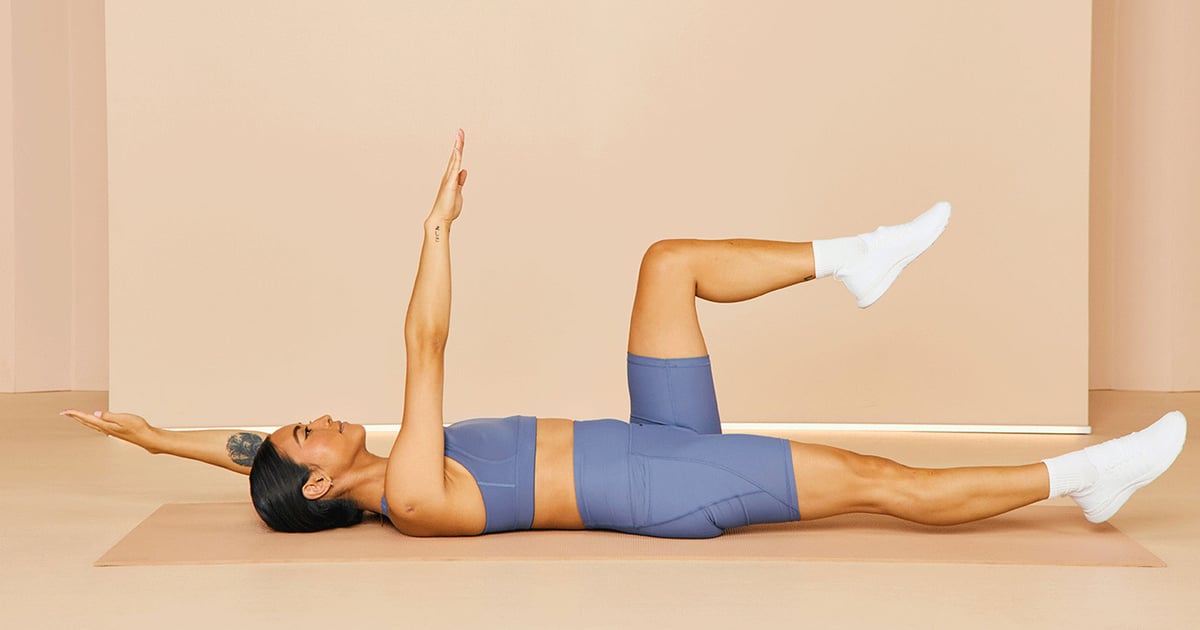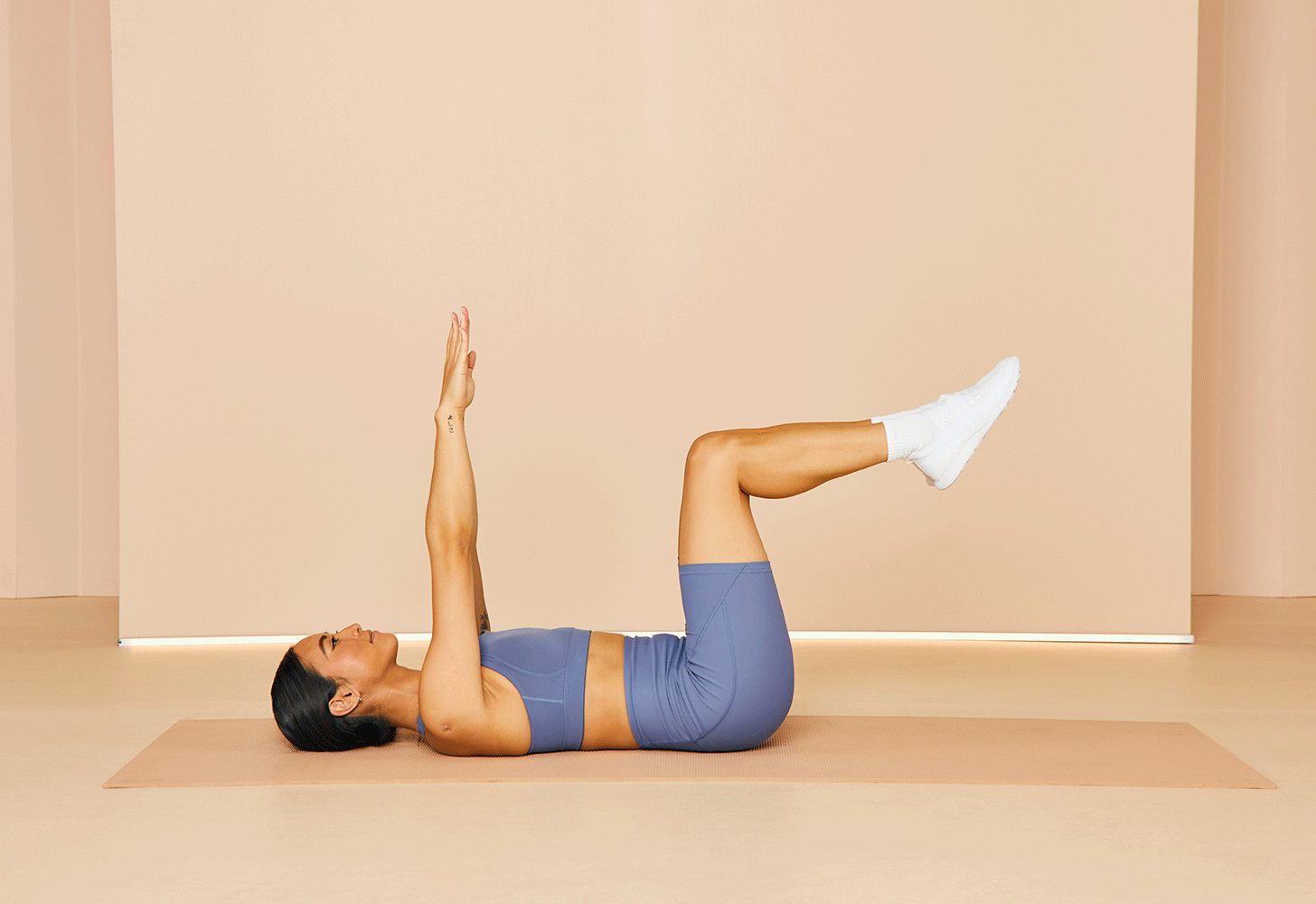Fitness
Dead Bugs May Not Be the Sexiest Exercise, but They Might Be the Best For Your Core

The dead bug exercise doesn’t sound like a glamorous core move. After all, what comes to mind is a dead roach or beetle on its back with its legs in the air. In reality, though, this beginner-friendly core move has a lot to offer — and there are plenty of reasons to add it to your exercise routine.
The biggest reason is because it’s a beginner-friendly, surefire way to build core strength and stability, which are both key to moving well in training and in life. In addition, doing dead bug regularly will contribute to better posture, coordination, power, and control. It can be performed anywhere on the go without equipment.
Ready to learn about this beginner-friendly move? Keep scrolling for everything you need to know about the dead bug exercise, including benefits, muscles worked, how to adjust it to different fitness levels, and step-by-step instructions to perform it safely.
The Benefits of the Dead Bug Exercise
The dead bug targets 360 degrees of core muscles, including the transverse abdominis (the deepest core muscle), rectus abdominis (the muscle in the front and middle of the abs), obliques (the muscles on the sides of your torso), and pelvic floor (the muscles along the bottom of your abdominal cavity, which work to hold up your internal organs).
Breanna Cummings, trainer for the NYC Nike Well Collective and Lifetime Fitness NYC, says the dead bug is a favorite to recommend for her clients. She describes it as a “functional movement that mimics daily life.” That’s because, compared to other core exercises like crunches or sit-ups, dead bug places the spine in a neutral position. It helps you build more core strength and stability while allowing your limbs to move freely — hugely important skills for moving through your day-to-day. “Think about how you carry groceries into the house, or pick up your favorite little human. All of these activities require a neutral spine, core strength, and stability,” she explains. The dead bug exercise also works shoulder and hip mobility, because it asks you to move your shoulders and hips through a large range of motion.
Its emphasis on core strength and mobility makes dead bug a great move for general strength and conditioning, as well as for athletes. For example, “runners need to be able to create power while keeping their core engaged in a neutral spine, so the better you’re able to perform the dead bug, the more efficient you will be,” Cummings explains.
If prescribed by a trainer, physical therapist, or doctor, dead bug can also be used to recover from injury and help with lower-back issues. The move is performed lying on your back and asks you to find and maintain a neutral spine, as well as a braced core; it’s also done slowly and, usually, in tune with your breath. This offers a really safe way to build core strength compared to more dynamic movements and helps people learn what it means to brace or engage your core.

How to Do a Dead Bug
Here’s how to perform a dead bug with safe and proper form, according to Cummings.
- Lie on your back on the floor. Lift your legs up to tabletop position, with your knees directly over your hips bent at 90 degrees and your shins parallel to the floor. Extend your arms toward the ceiling, stacked directly over your shoulders, palms facing each other.
- From this position, flatten your back to the floor by tilting your pelvis slightly upward. This is your starting position.
- Exhale to slowly extend one arm behind your head while simultaneously extending your opposite leg until it’s straight, hovering just off the floor. Try not to let your lower back lift off the floor (if it does start to lift, don’t lower your leg as far, as shown below).
- Hold for one second, then inhale to lift both your arm and leg back to the starting position.
- Repeat on the other side. That’s one rep.
Dead Bug Variations and Modifications
Even though dead bugs are a beginner-friendly move, there are ways to both decrease the challenge — so you can really connect to your core — and up the ante. Try these three dead bug variations.
Banded Dead Bug: Adding a resistance band usually makes an exercise harder, but in this case, it’s a modification; this dead bug variation helps you activate your core and breaks down the movement to just the feet. Try this modification if you’re having trouble moving both your arms and legs while keeping your core engaged. Loop a resistance band onto a pole or piece of furniture, then lie face-up on the floor so the band is just past your head. Holding onto the band with both hands, press your back flat onto the floor, and pull the band until your hands are above the middle of your chest. Lift your legs up to tabletop, and hold for 15-20 seconds. Next, try performing the dead bug movement with your feet only, holding the band in place above your chest.
Weighted Dead Bug: If you have access to a weighted plate or dumbbells, this is a great exercise. You only need to add 5-10 lbs. to this exercise. It works not only your core but also shoulder mobility. To do it, hold the weight in your hands and perform dead bug by moving the weights toward the floor as far as you can. Be careful here: you only want to go as far as you feel a stretch in your shoulder. If you go too far, you can put yourself at risk for shoulder injury.
Medicine Ball Iso Dead Bug: This one will set your core on fire! Grab a 5-8 lb. medicine ball. Lie on the floor, and place the medicine ball in between your right elbow and left knee. Engage your core, and press your back against the floor. Extend your opposite arm and leg in the usual dead bug motion while maintaining tension on your other elbow and leg to hold the medicine ball up. With this move, it’s important that you focus on your breath, breathing in and out through your nose. If the medicine ball is too heavy, you can substitute for a yoga block or a stability ball; all versions of this move make sure your core stays locked and engaged while you work the opposing side.
Image Source: POPSUGAR Photography / Chaunté Vaughn

Fitness
The Home Fitness Revolution: How Indoor Cycling Solves Modern Exercise Challenges.

The Home Fitness Revolution: How Indoor Cycling Solves Modern Exercise Challenges.
In today’s fast-paced world, millions of people struggle with a common dilemma: staying fit while juggling work, family, and social commitments. Despite good intentions, gym memberships often go unused, outdoor workouts depend on weather, and finding time for exercise becomes increasingly difficult. This widespread problem has led to a fitness revolution that’s transforming how we approach health and wellness at home.
## The Modern Fitness Crisis: Why Traditional Workouts Fail
### Time Constraints That Sabotage Fitness Goals
Research reveals that 73% of adults cite lack of time as their primary barrier to regular exercise. Between commuting, work schedules, and family responsibilities, finding time for gym visits becomes nearly impossible. The average person spends almost an hour daily commuting, leaving little energy or time for additional travel to fitness facilities.
This time crunch creates a vicious cycle where people purchase gym memberships with good intentions but can’t maintain consistent usage. The result? Wasted money, guilt, and deteriorating health outcomes that could be prevented with the right approach to **home fitness equipment**.
### The Financial Burden of Traditional Fitness
Gym memberships cost between $40-80 monthly, totaling nearly $1,000 annually. Add personal training sessions at $50-100 per hour, and the financial burden becomes overwhelming for many households. These recurring costs, combined with travel expenses and specialized workout gear, make traditional fitness approaches financially unsustainable for most families.
## The Solution: Indoor Cycling Transforms Home Workouts
### Why Indoor Cycling Works When Other Methods Fail
Indoor cycling addresses the core problems preventing consistent exercise routines. Unlike complex **home gym equipment** that requires extensive space and setup, a quality exercise bike provides a complete cardiovascular workout in minimal space. The convenience factor alone increases workout consistency by up to 40% compared to gym-based routines.
**Stationary bikes for home use** have evolved dramatically, incorporating advanced technology that rivals expensive studio classes. Modern indoor cycling bikes feature smart connectivity, allowing users to access thousands of guided workouts, virtual cycling routes, and real-time performance tracking from the comfort of home.
### Key Features That Make Indoor Cycling Effective
The most effective **indoor exercise bikes** combine several critical features:
**Adjustable Resistance Systems**: Professional-grade resistance mechanisms allow users to customize workout intensity from beginner to advanced levels. Magnetic resistance systems provide smooth, quiet operation perfect for apartment living or early morning workouts.
**Smart Technology Integration**: Connectivity with popular fitness apps like Peloton, Zwift, and iFit transforms solitary workouts into engaging, interactive experiences. Users can join virtual classes, compete with others, or explore scenic cycling routes worldwide.
**Ergonomic Design**: Fully adjustable seats and handlebars accommodate users of various heights while ensuring proper form and comfort during extended sessions. This adaptability prevents injury while maximizing workout effectiveness.
## Health Benefits That Extend Beyond Basic Cardio
### Cardiovascular Excellence Through Indoor Cycling
Regular cycling workouts significantly improve heart health, reducing cardiovascular disease risk by up to 35%. The ability to maintain target heart rate zones through adjustable resistance makes **cardio equipment for home** highly effective for both beginners and advanced athletes.
High-intensity interval training (HIIT) becomes incredibly accessible with proper indoor cycling equipment. These intense sessions burn 400-600 calories while creating an “afterburn effect” that continues burning calories for up to 24 hours post-workout.
### Weight Loss and Body Composition Improvements
**Best exercise bikes for weight loss** provide sustainable, low-impact exercise that supports gradual, healthy progress. The combination of high caloric burn and lower body strength development creates ideal conditions for body composition improvements without joint stress common in running or high-impact activities.
### Mental Health and Stress Relief Benefits
Indoor cycling provides significant psychological benefits including reduced anxiety, improved mood regulation, and enhanced cognitive function. The rhythmic nature of cycling promotes mindfulness while achievement of fitness goals builds confidence and self-efficacy.
## Choosing the Right Equipment for Long-Term Success
### Essential Features in Quality Exercise Bikes
When selecting **home cardio equipment**, several factors determine long-term satisfaction and results:
**Build Quality and Durability**: Commercial-grade construction ensures equipment withstands daily use while supporting users up to 300+ pounds. Heavy-duty flywheels (35+ pounds) provide smooth, consistent resistance that closely mimics outdoor cycling experiences.
**Quiet Operation**: Belt-drive systems and magnetic resistance create whisper-quiet operation under 30 decibels, perfect for apartment living or homes where noise is a concern.
**Space Efficiency**: Compact designs that fit in bedrooms, living rooms, or small home offices maximize accessibility while maintaining stability during intense workouts.
### Technology Integration for Enhanced Motivation
Modern **fitness bikes** feature comprehensive app connectivity, tablet holders, and real-time performance monitoring. These technological advances address the motivation challenges that cause most home fitness equipment to become expensive clothes hangers.
Built-in LCD displays provide essential metrics including speed, distance, calories burned, and heart rate monitoring. This data helps users track progress while maintaining target training zones for optimal results.
## Real-World Success Stories and Applications
### Busy Professional Integration
Working professionals consistently report success integrating indoor cycling into demanding schedules. The ability to complete effective 20-30 minute sessions during lunch breaks or early mornings provides flexibility impossible with traditional gym memberships.
Corporate wellness programs increasingly recommend **home fitness solutions** because employees who exercise regularly show improved productivity, reduced sick days, and better stress management.
### Family Fitness Solutions
Quality exercise bikes accommodate multiple family members with different fitness levels through adjustable designs. Parents report increased motivation when children observe consistent healthy habits, creating positive family examples around wellness priorities.
The quiet operation allows workout routines without disrupting family activities, homework sessions, or nap times, making it practical for busy parents to maintain consistency.
## Investment Analysis: Long-Term Value
### Cost-Effectiveness of Home Equipment
A quality exercise bike typically costs equivalent to 6-8 months of premium gym membership fees but provides unlimited access for multiple family members over many years. The durability of commercial-grade equipment ensures decades of reliable use, making the per-workout cost negligible over time.
Hidden savings include eliminated transportation costs, parking fees, and the time value gained by avoiding commutes to fitness facilities. This time savings adds 30-60 minutes daily that can be redirected toward family, career, or personal development.
### Health Investment Returns
Regular exercise provides substantial long-term healthcare cost savings through reduced disease risk and improved immune function. The CDC estimates every dollar invested in preventive fitness activities saves $3-5 in future healthcare costs.
Insurance companies increasingly offer premium discounts to policyholders who maintain consistent exercise routines, recognizing the reduced risk profiles associated with regular physical activity.
## Setup and Optimization for Maximum Results
### Creating Your Home Fitness Space
Successful home cycling setups require minimal space but maximum accessibility. Choose locations with adequate ventilation, ceiling height for standing positions, and proximity to power outlets for device charging.
Consider flooring protection with rubber mats to prevent equipment movement while protecting floors from potential damage. Proper lighting and ventilation enhance workout comfort while reducing equipment wear over time.
### Maximizing Workout Effectiveness
Establish consistent schedules aligned with personal energy levels and daily commitments. Morning sessions often provide sustained energy throughout the day, while evening workouts help reduce stress and improve sleep quality.
Incorporate variety through different resistance levels, riding positions, and workout durations to prevent boredom while challenging different muscle groups. Periodization principles that gradually increase intensity and duration produce 40% better fitness improvements compared to random workout approaches.
## Transform Your Health with the Right Equipment
The revolution in **home exercise equipment** has made professional-grade fitness accessible to everyone, regardless of schedule constraints or budget limitations. Quality indoor cycling bikes address the core challenges that prevent consistent exercise while providing comprehensive health benefits that extend far beyond physical fitness.
Success depends on choosing equipment that combines durability, technology integration, and user-focused design to create sustainable workout routines. The investment in quality home fitness equipment pays dividends through improved health, significant cost savings, and the invaluable convenience of accessible exercise opportunities.
For those ready to transform their health and fitness journey, finding the right equipment that meets individual needs and preferences is crucial. If you’re serious about making lasting positive changes and want expert guidance on selecting the perfect indoor cycling solution for your home, visit [PrimFitX](https://primfitx.com) to discover professional recommendations and exclusive deals on top-rated exercise bikes that deliver real results.
The time for excuses has ended. The tools for transformation are available, affordable, and waiting in your living room. Make the decision today to invest in your long-term health, save money on expensive gym memberships, and gain the flexibility to exercise on your terms. Your future self will thank you for taking this crucial step toward better health and wellness.
Fitness
We Consulted Fitness Experts to Learn the Truth About Vibration Plates for Weight Loss

Step aside mom jeans, scrunchies and denim on denim, there’s another trend making a comeback. Vibration plates are trending once again. Similar to the mid-20th-century vibrating belt machines, vibration plates have been said to provide the body with various benefits and can even be a tool for weight loss. But is the hype backed by science and expert opinions, or is it all social media hearsay?
To find out if you should add a vibration plate to your workout routine, we asked personal trainers and other fitness experts about the benefits, risks, how to use a vibration plate and more.
What is a vibration plate?
Whole body vibration plates is are a form of exercise machine that shakes rapidly when you stand on it. When you stand on a vibration plate, you’re engaging in a full body vibration exercise, where your muscles are forced to contract and relax quickly.
“The purpose of vibration plates is to generate quick vibrations that cause your body’s muscles to contract and relax several times per second,” says Dr. Leah Verebes, a physical therapist and assistant professor at Touro University’s School of Health Sciences. “At a far greater frequency, this resembles the spontaneous contractions that take place during exercise.”
“This stimulates a subconscious muscle activation each time the machine moves, meaning your muscles are activating far more than they would on a stable surface,” says Laura Wilson, a personal trainer at Life Time Fishers and director of training and curriculum at Power Plate, a company that produces vibrating exercise machines.
There are several ways to use a vibration plate, the most common being standing on its rectangular platform. However, you can also perform squats or push-ups on it.
Wilson says vibration plates can move in multiple directions: up and down, side to side and front to back. The harmonic vibrations move between 25 to 50 times per second, activating the corresponding muscles.
Vibration plate benefits
Yes, there are health benefits to using vibration plates. According to Verebes, some of the advantages may include “improved muscle tone and strength, better circulation, higher bone density, improved flexibility and balance, lymphatic drainage and the possibility of weight loss when paired with a healthy diet and regular exercise.”
However, experts agree that vibration plates offer the most benefits when used as part of an overall health and wellness plan. In other words, you shouldn’t expect to lose weight or increase muscle strength just by standing on a vibration plate — even if social media makes it seem so. Instead, experts suggest supplementing vibration exercise with other healthy habits, including a balanced diet and aerobic and strength training.
“Vibration plates are not a magic bullet or a replacement for traditional exercise,” warns Michael Betts, a personal trainer and director at TRAINFITNESS. “The benefits are modest and work best when combined with other forms of training.”
Still, research indicates that using vibration plates can have positive effects on your health. For example, one 2021 study looked at whether whole-body vibration training could improve muscle strength in older adults, concluding that it “may be an alternative exercise method to boost the effect of strengthening exercise.”
Similarly, a 2007 study investigated the effects of whole-body vibration training in men over 60 and found that it has the “potential to prevent or reverse the age-related loss in skeletal muscle mass, referred to as sarcopenia.”
Other research suggests that vibration-based exercise may help improve bone mass density, reduce inflammation, alleviate chronic low back pain and more.
Vibration plate risks
For most, vibration plates are generally safe. However, like any other type of exercise, they come with a few potential risks, including “aggravation of existing conditions, temporary dizziness and joint stress if used incorrectly,” according to Betts.
There are also certain groups of people who should avoid using vibration plates altogether. “Vibration plates shouldn’t be used by anyone with cardiac or circulatory disorders, such as deep vein thrombosis (DVT) or pacemakers; pregnant women; people who have just had surgery; and people who have severe osteoporosis,” Verebes says.
“People with pre-existing disorders, including herniated discs, joint issues or acute inflammation, may experience worsening symptoms when using vibration plates,” she adds. “The vibrations may also be disconcerting to people who have inner ear problems or balance abnormalities.”
Verebes points out that “excessive use or high-intensity vibrations may strain ligaments, muscles or joints.”
Even if you don’t have one of these conditions, it’s still a good idea to talk to your doctor before getting on a vibration plate.
It’s also worth mentioning that a 2015 study discovered a link between regular exposure to whole-body vibration and a higher risk of lower back pain and sciatica. However, the participants in that study were regularly exposed to vibration as part of their jobs, so the results may not apply to vibration plate users.
How often should you use a vibration plate?
If you’re new to whole-body vibration training, it’s important to start slowly.
“To allow the body to adapt to vibrations, beginners should start with 5 to 10 minutes at a low intensity,” says Verebes. “Moderation is key, as excessive use may lead to fatigue or injury.”
As a beginner, it’s best to limit yourself to two to three sessions per week, says Betts. Over time, you can work toward longer and more frequent sessions. “As your body adapts, you can increase to 15- to 20-minute sessions up to 3 to 4 times a week,” he says. “Never go over 30 minutes, as this can cause fatigue and joint stress.”
For proper recovery, Betts also recommends leaving at least 24 hours between vibration plate sessions. “Listen to your body and adjust accordingly,” he advises. “Quality of movement matters more than duration.”
Vibration plate exercises
To use a vibration plate, you can simply stand in place with slightly bent knees. You can also engage in other exercises — like squats or push-ups — while using the machine.
“Incorporating exercises such as squats, lunges, planks, push-ups and core workouts enhances results by engaging more muscle groups and boosting calorie burn,” says Verebes.
If you’re up to the challenge, here are three vibration plate exercises to try, as recommended by Wilson:
Push-ups
“Push-ups work your chest and shoulders — and doing them on a vibration plate activates many more muscle fibers per second than if you were to do them on the floor,” says Wilson.
To perform a push-up on a vibration plate, follow these steps:
- Get into a high plank position by placing your palms flat on the platform and stretching your legs long behind you.
- Lower into a push-up position slowly. Your chest should come close to touching the platform.
- Perform three sets of 10 reps, taking 30 seconds of rest between each set.
High plank holds
You can also use a vibration plate to perform a high plank hold, which is “great for your core and upper body strength,” says Wilson. Here’s how:
- Get into a high plank position by placing your palms flat on the platform and stretching your legs long behind you.
- Hold for 30 seconds. Perform three sets, taking 15 seconds of rest between each set.
Tricep dips
“This exercise works the back of the arm as well as the shoulder,” says Wilson. “You’re going to experience much more muscle activation when doing it on a vibration plate machine.” Here’s how:
- Sit on the edge of the platform.
- Place your palms on the platform (just outside of your hips). Keep your feet flat on the ground with your knees bent at a 90-degree angle.
- Scoot forward until you’re hovering in front of the platform, only supported by your arms and legs.
- Lower your hips toward the ground by bending at the elbows, stopping when your elbows reach 90 degrees or when you can’t lower your hips further.
- Push through your palms and return to the starting position.
- Perform three sets of 10 reps, taking 30 seconds of rest between each set.
Do vibration plates work if you just stand on them?
You don’t need to perform exercises while using a vibration plate, but experts say moving your body — rather than standing still — will help you get more out of the machine.
“Actively moving while using the plate maximizes its benefits, even though simply standing on it can support circulation and balance,” says Verebes.
Betts agrees, adding: “Standing still on a vibration plate provides some stimulus through the muscle contractions, but adding movement increases the benefits. Static positions can help with circulation and muscle activation, but dynamic exercises will give you strength gains, balance improvements and overall training effects.”
If you’ve never used a vibration plate before, you could begin by standing in place or squatting while you’re on the machine. As you get more comfortable, you can incorporate different exercises and positions. Or you can alternate between standing still and exercising, suggests Betts.
“Combine both approaches — use static holds to build comfort and awareness, then move for optimal results,” he says. “Form and progression are key regardless of whether you’re moving or holding positions.”
The bottom line
Simply scrolling through social media, you might get the idea that vibration plates are an easy, low-commitment way to transform your body. While it’s true that vibration plates offer some compelling benefits, they aren’t a shortcut to fitness.
To get the best results from your vibration plate training, experts also recommend following a healthy diet and participating in other forms of exercise. It’s also a good idea to speak with your doctor before you start using a vibration plate — especially if you’ve had blood clots, joint issues or other health conditions.
A vibration plate can help you lose weight when paired with a balanced diet and regular exercise. However, standing on a vibration plate without exercise will not.
Vibration plates generate quick vibrations that contract and relax your body’s muscles several times per second, resembling at a greater frequency the spontaneous contractions that happen when you exercise normally. They can also move in multiple directions, activating different muscles.
Fitness
Smarter, safer workouts with a wearable fitness tracker – Harvard Health

Do you need a little extra inspiration to be more active throughout the day? Or perhaps you’re wondering if your workouts are challenging enough to optimize your cardiovascular health. And if you have any type of heart disease, you’ll want to be sure you’re not pushing yourself too hard during vigorous physical activity. For each of these situations, a wearable fitness tracker may be a worthwhile investment, especially when you consider that exercise is widely considered the best medicine — not just for your heart but for your overall health.
You may already own such a device, as most smart watches include a range of fitness tracking features alongside their other functions. Other options include wrist-worn bands and smart rings that focus primarily on health and fitness tracking.
“The information these wearables provide is measurable, meaningful, and motivating,” says Dr. Sawalla Guseh, director of the Cardiovascular Performance Program at Harvard-affiliated Massachusetts General Hospital. “It’s like having a goal-setting coach with you around the clock,” he says.
Long-term monitoring may also alert you to heart problems, says Dr. Guseh. “I had one patient who didn’t feel chest pain or related symptoms, but he noticed his exercise performance declining over time. It turned out he had coronary artery disease,” he says.
Features to watch
Here are some of the features on wearable fitness devices that are worth checking out.
Stand or move reminders. Many wearables feature customizable notifications — a message on the watch face or a sound or vibration — to remind you to stand up and move around for a short period of time to break up long stretches of sitting. Even dedicated runners need to avoid being sedentary throughout the day to keep their hearts healthy, says Dr. Guseh (see “Stand up for your heart” in the June 2025 Heart Letter).
Daily step counts. Although you’ve likely heard that 10,000 steps per day is a good goal, that number was based on a Japanese marketing scheme and not actual data. Recent evidence finds that a lower number — anywhere from 4,000 to 7,000 daily steps — is linked to improved heart health. A smartphone (provided you carry it with you most of the day) can give a close estimate of your daily step count, but a wearable will be more accurate. Data from your smart watch automatically syncs with your smartphone, and most have apps that display trends in your step counts and other exercise data over weeks, months, and years.
Heart rate zones. Wearables make it easier to assess your exercise effort with heart rate zones, which classify how intensely you’re exercising by measuring your heart rate. The zones are based on your maximum (or peak) heart rate (MHR) — an estimate of the upper limit of what your cardiovascular system can handle during physical activity. A commonly used formula for MHR is 220 beats per minute minus your age, but you should consider this a ballpark figure, since factors other than age are at play.
Different wearables have varied numbers of heart rate zones, although five is typical. Zones 2 and 3 are generally thought to correspond to moderate-intensity exercise, while zones 4 and 5 correspond to vigorous-intensity exercise. But because they’re not individualized, they may not be accurate for everyone, Dr. Guseh notes. Ideally, you should do at least 150 minutes of moderate-intensity exercise, or 75 minutes or more of vigorous-intensity exercise, or an equivalent combination every week.
Heart rate recovery (HRR). This value reflects your heart’s ability to return to its normal, resting pace after you stop exercising. It’s the difference between your peak heart rate during exercise and your heart rate at a set time after you stop (typically one to two minutes). A value of 20 beats per minute is considered good, and higher is even better.
Maximal oxygen consumption (VO2 max). This value is the maximum amount of oxygen a person can use during intense exercise. It can be measured directly when a person runs on a treadmill with an oxygen mask in a lab. Some wearables estimate it based on an algorithm that uses data such as your MHR, HRR, pace, weight, and sex. VO2 max is a powerful predictor of cardiovascular health. “The absolute number may not always be accurate, but the trends can be useful. If your VO2 max rises over time, that’s a strong sign your training is improving your fitness,” says Dr. Guseh.
Heart rate variability (HRV). This value is a measure of the variation in time between heartbeats — differences that are just fractions of a second. More variability (a higher value) suggests better heart health, because it reflects the heart’s ability to respond quickly to rapid changes occurring throughout the body. Most wearables report this value, but there isn’t a recommended target because it varies widely depending on your age, sex, fitness level, and medical history. However, it can be useful to track trends in your HRV over time. HRV often falls after a period or stress or illness but then bounces back — a sign that you’re good to go back to exercising, says Dr. Guseh.
Exercising after a heart disease diagnosis
Anyone who’s had a heart attack, heart surgery, or other heart disease diagnosis should attend cardiac rehabilitation, a personalized program of supervised exercise and heart-healthy lifestyle coaching. It starts with an exercise stress test, which involves closely monitoring your heart during exercise to tailor an effective yet safe exercise program for you.
“Cardiac rehab is a tried-and-true method of helping people get back into shape, with a standardized protocol that works well for most people,” says cardiologist Dr. Sawalla Guseh, assistant professor of medicine at Harvard Medical School. However, people who were previously exercising at higher intensities and therefore quite fit may get bored at cardiac rehab because it’s too easy for them, he says. If that’s the case for you, consider requesting a referral to a sports cardiologist, who can provide more rigorous and detailed testing and advice, including a specific heart rate threshold you should be careful not to exceed.
|
Image: © Oscar Wong/Getty Images
-

 Iowa1 week ago
Iowa1 week ago8 ways Trump’s ‘Big, Beautiful Bill’ will affect Iowans, from rural hospitals to biofuels
-

 Politics1 week ago
Politics1 week agoConstitutional scholar uses Biden autopen to flip Dems’ ‘democracy’ script against them: ‘Scandal’
-

 Politics1 week ago
Politics1 week agoDOJ rejects Ghislaine Maxwell’s appeal in SCOTUS response
-

 Health1 week ago
Health1 week agoNew weekly injection for Parkinson's could replace daily pill for millions, study suggests
-

 Culture1 week ago
Culture1 week agoTest Your Knowledge of French Novels Made Into Musicals and Movies
-

 News1 week ago
News1 week agoSCOTUS allows dismantling of Education Dept. And, Trump threatens Russia with tariffs
-
Business1 week ago
Musk says he will seek shareholder approval for Tesla investment in xAI
-

 Sports1 week ago
Sports1 week agoEx-MLB pitcher Dan Serafini found guilty of murdering father-in-law















